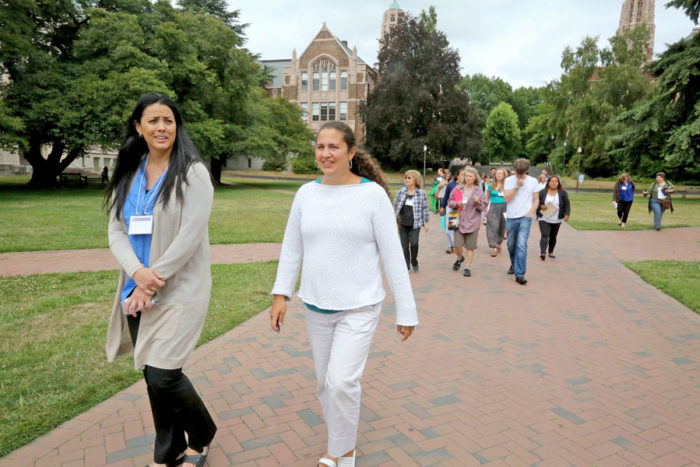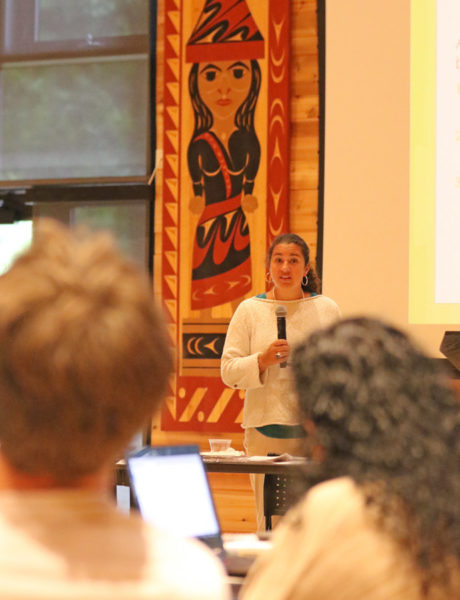
I’ve spent seven years hustling across the UW’s iconic, cherry-tree-lined “Quad” on my way to teach journalism classes. But it wasn’t until this week that I learned those red brick pathways zigzag over what was once a Duwamish village.
“Are you sure you know where you are standing?” asks Professor Megan Bang co-director of the new Native Education Certificate Program at the University of Washington.
She’s speaking to roughly 30 educators — some Native, some non-Native — from across Washington who crowd around her for this walk focused on “coming to know the land” of the UW’s campus. They’ve joined the program’s first cohort — 69 in total — to learn how to better teach about Native American issues in their schools and work better with Native American youth and families in their communities.
“Just think about what has changed in 250 years on this site,” Bang adds before the group moves on, occasionally parting to allow a student to bustle past, face buried in their phone.
This is what Bang, and the Native Education Certificate Program, call “land-based” or “place-based” learning, and it’s one of the pedagogical approaches these educators will learn over the course of the next two years.
One of the first field trips on the program will be to a series of locations tribal elders have identified as important places for a child of the Spokane Tribe to know. Program participants will then “backward map” issues related to their classroom learning goals. For example, a traditional harvest location can lend itself to learning about science, the environment and history.
“Thinking about place and land is central to education,” says Bang, who believes this approach can be applied to every subject, “We didn’t always only learn in buildings. And that’s not only true in Native communities.”
In addition to discovering new approaches to teaching, program participants will also address cultural insensitivity, racism and bias in existing curricula — issues Bang says her own two children have experienced in school all too often.

“I think learning about the Oregon Trail is very important, but it’s almost always learned from the perspective of settlers,” she says explaining how her own daughter, who is Native, struggled to identify as a pioneer when studying the Oregon Trail in school, “[The curriculum] didn’t ask what were the long-term consequences for Native kids and Native people.”
Experiences like that can make relationships between educators and Native students and families challenging. In response, the program hopes to help educators learn more about the cultural and historical context of the communities they work in.
“I think building trust with the community is number one,” says Mark Jacobson, Principal and Superintendant for the Quileute Tribal School in La Push, Washington.
Jacobson, a non-Native, says he joined the Native Education Certificate Program because he wants to be able to better communicate and work with Native families
“If you look at the relationship between Natives, the state of Washington and the federal government, we’ve created so much mistrust,” says Jacobson, referencing historical policies of forced cultural assimilation through government-run schools. “Some of our [school’s] grandparents were in boarding schools. It’s going to take some time to build those relationships.”
Bang says the program was a result of decades of requests to the UW from tribal leaders who were concerned about academic achievement gaps, inadequate education and a lack of Native teachers in their communities. But she is quick to add that these approaches are good for everyone.
“We happen to think that a lot of the pedagogy we teach is good for all kids,” says Bang, citing the universal importance of education that is culturally relevant, historical sensitivity and respectful of students and families. “The principles are just good teaching.”
After just a couple hours of land-based learning, I know I’ll never look at the UW campus the same way again.

